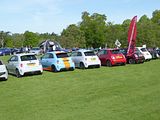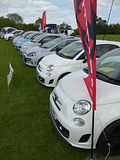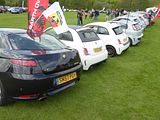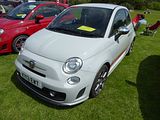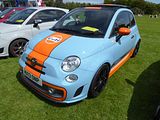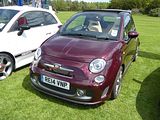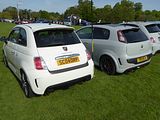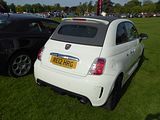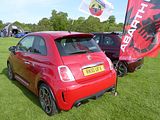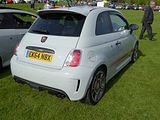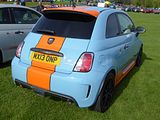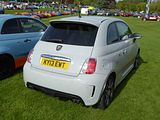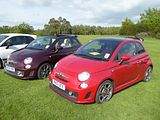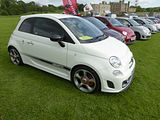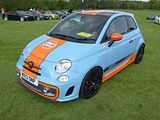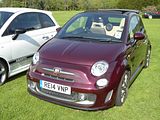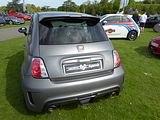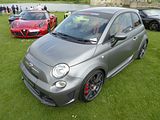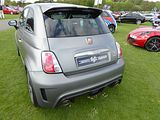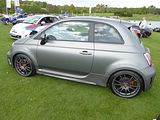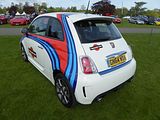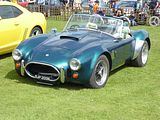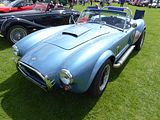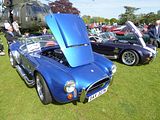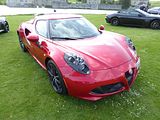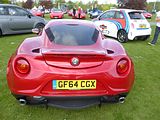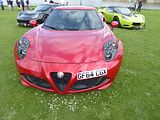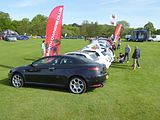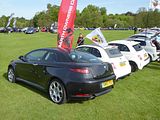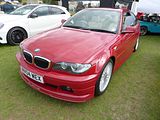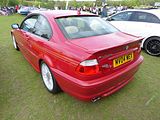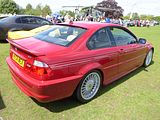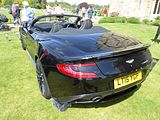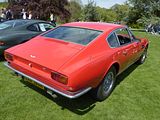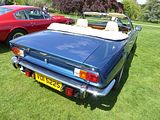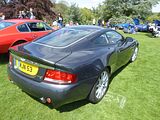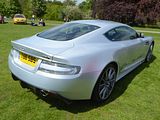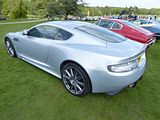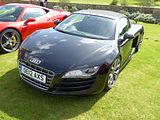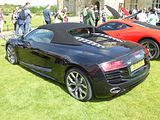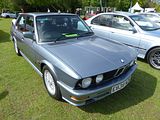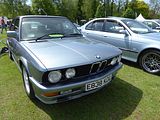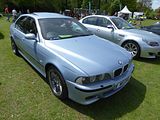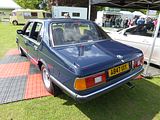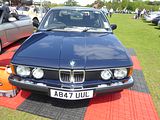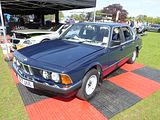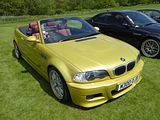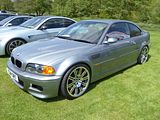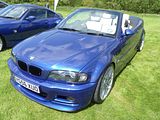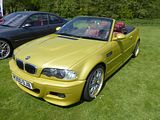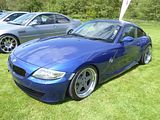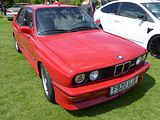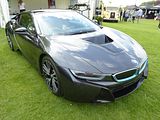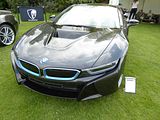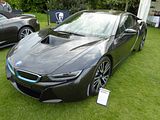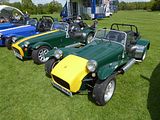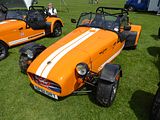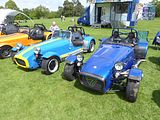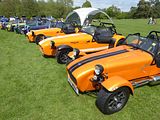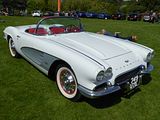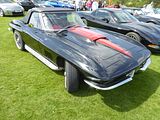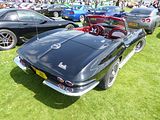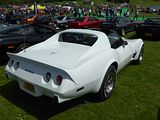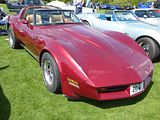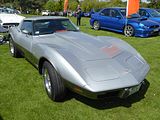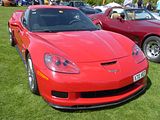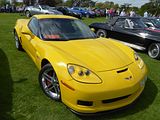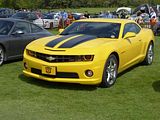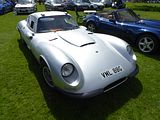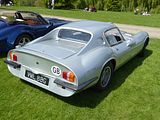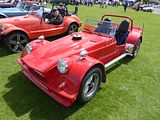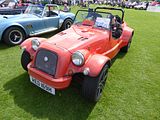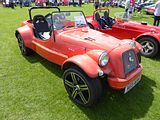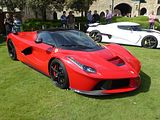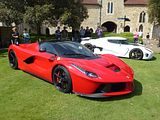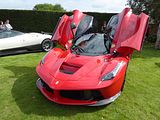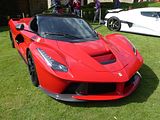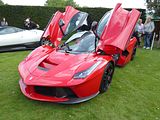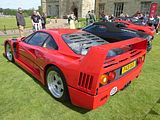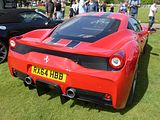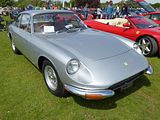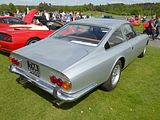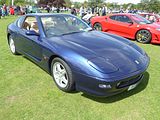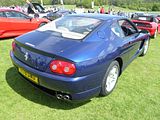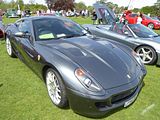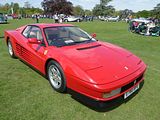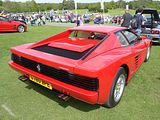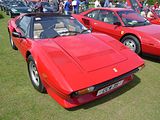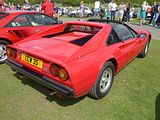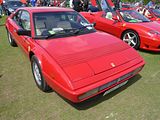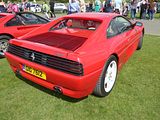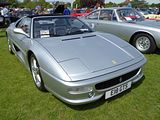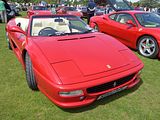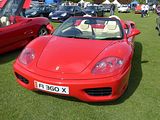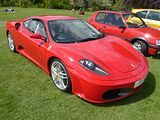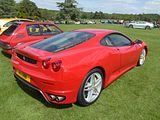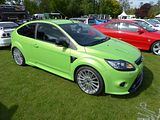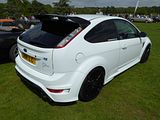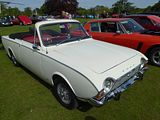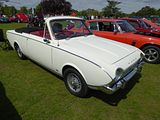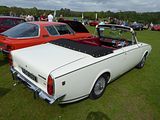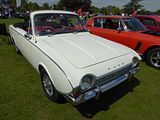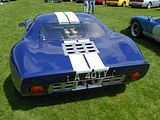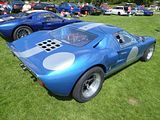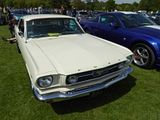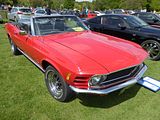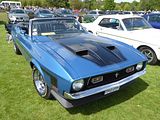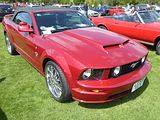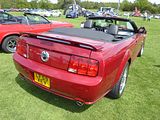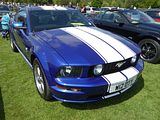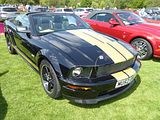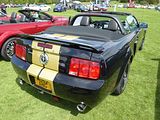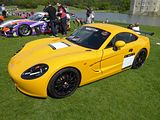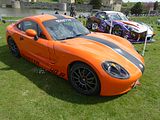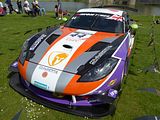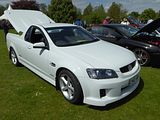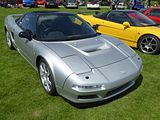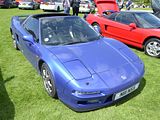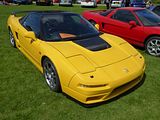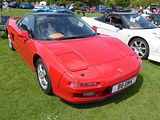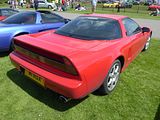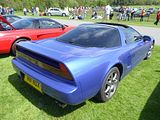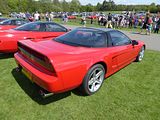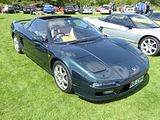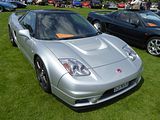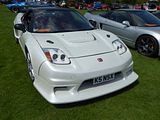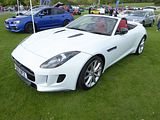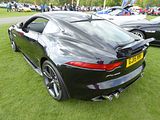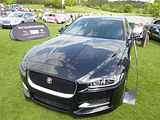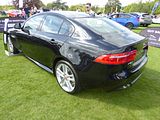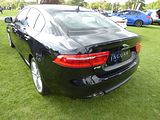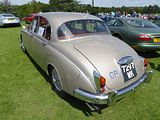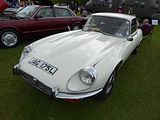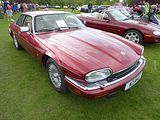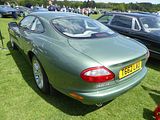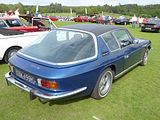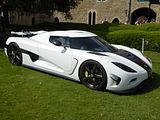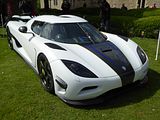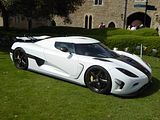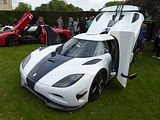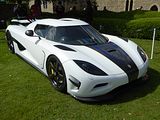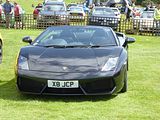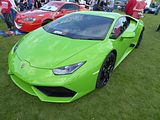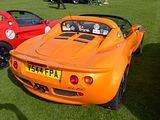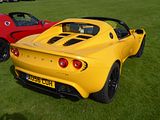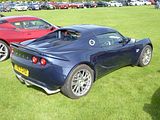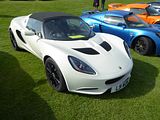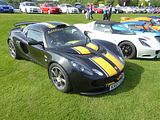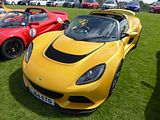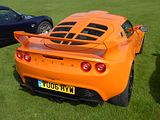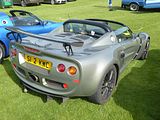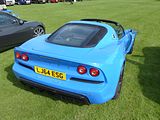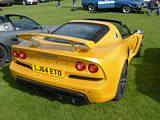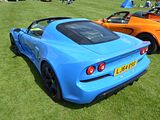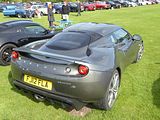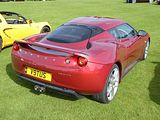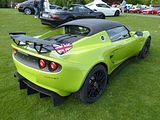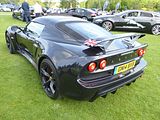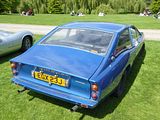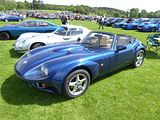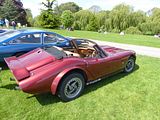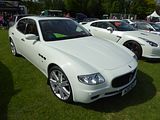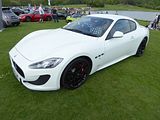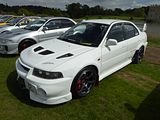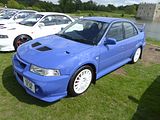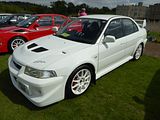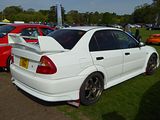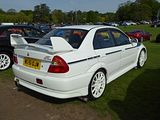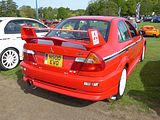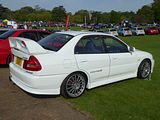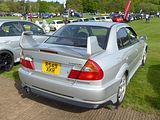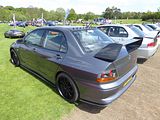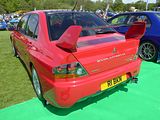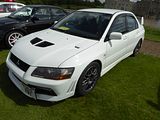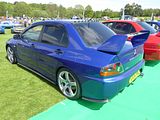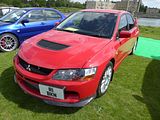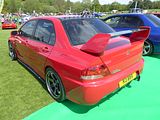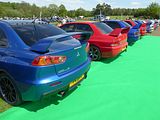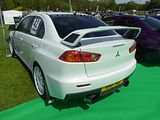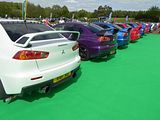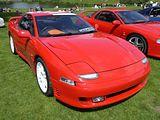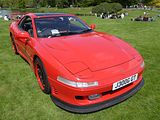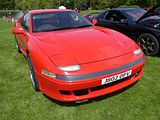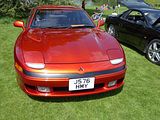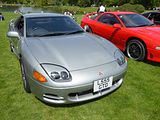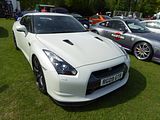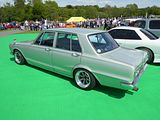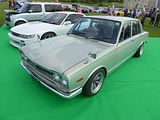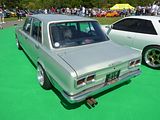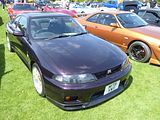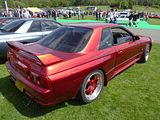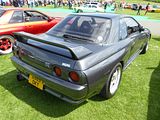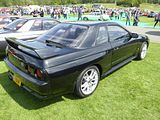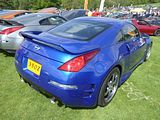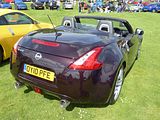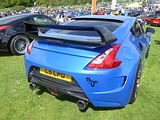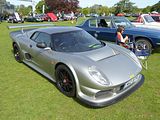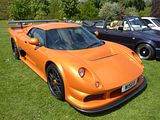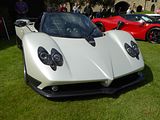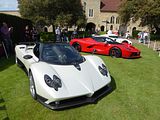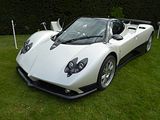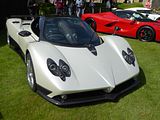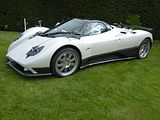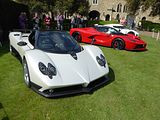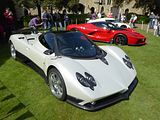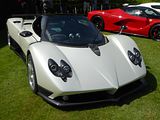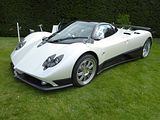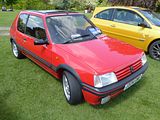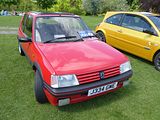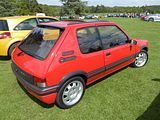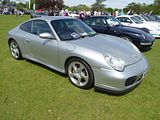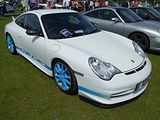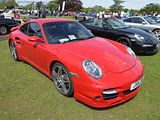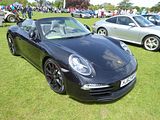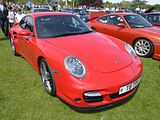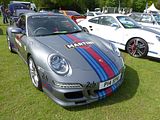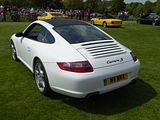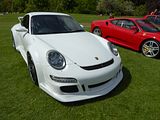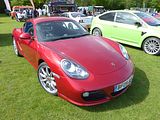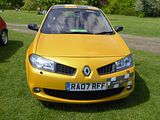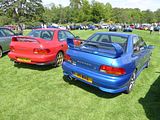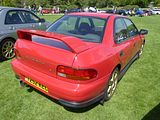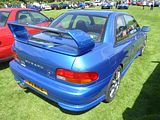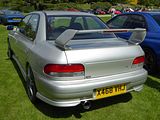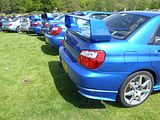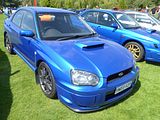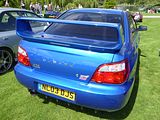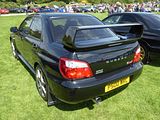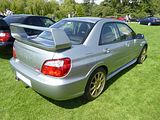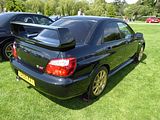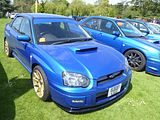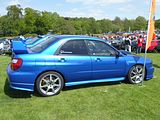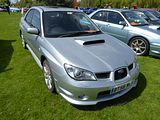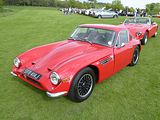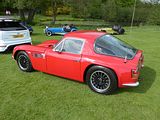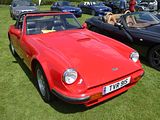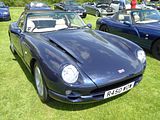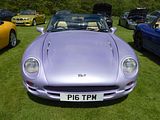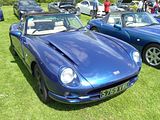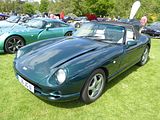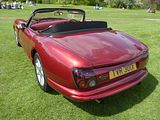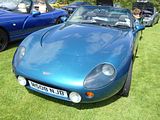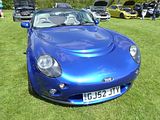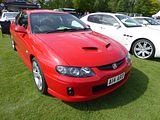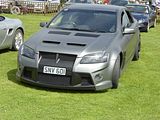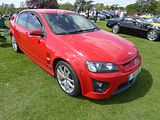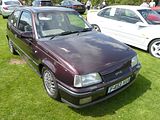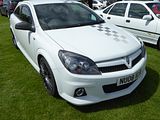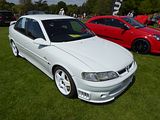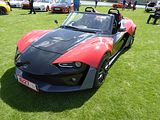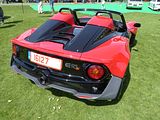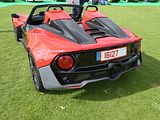It may be an inconvenient truth for those politicians and councillors who seem hell-bent on trying to make life as difficult as possible for the motorist, but the reality is that there are huge numbers of people who are interested in cars, so any event which gathers more than a few of them together is likely to get a good audience. Put the word “supercar” in the title of the event, and you really can’t fail to get a sizeable audience. That cannot have been lost on the organisers of an event which has now been running for three years, in the fabulous setting of Leeds Castle in Kent, who conceived the notion not just of providing a day out that many an enthusiast would enjoy, but also to use the opportunity to raise much–needed funds for the Royal Navy and Royal Marine Childrens’ Fund. I’d seen reports and pictures of SuperCar Siege in previous years, but Leeds Castle is an awfully long way from my home in Bristol, so with a busy diary, it had never quite got the priority that it perhaps deserved in previous years. But when there was talk on Abarth Owenrs Club of doing a London to Brighton run, and several of the same people were also interested in the Siege, it dawned on us that combining the two was quite a smart idea. And so, arrangements were made for an Abarth Owners Club display area, which would get us into the heart of the event, earlier than the general public admission, which is never a bad thing if you want to see cars close up and to get photos devoid of crowds. Following a fun day on our London to Brighton run, documented elsewhere, many of the same enthusiasts gathered, as arranged, at the Services at junction 8 of the M20, only to find that just about every other club had had the same idea. We watched some of the depart, whilst we were still assembling the last of our convoy, but even though those Clubs were ahead of us, there was negligible queuing on the short journey into the grounds of the Castle, and by 8am we were all parked up. Over the next hour or so, a vast area of lawn, with the spectacular back drop of the castle filled up with cars, imaginatively grouped together in diverse patterns, following some very subtle markings on the ground which only really evident when you looked hard. As well as a number of Car Clubs, a couple of local dealers had cars on show, and the Sporting Bears were here with a range of cars in which people could have passenger rides in exchange for a donation to the event’s charity. The drivers of these cars were kept very busy, with all of them sold out all day long. The special “hypercars” were shown in an area inside the outer walls of the Castle (getting them there must have been a tight squeeze!). I understand that the event turned out to be significantly bigger than in previous years, and there was certainly plenty to see, and, as the morning progressed, plenty of people seeing it. Here, then, are my photographic highlights of the day.
ABARTH
10 cars is what we had booked, and 10 cars were in the Abarth Owners Club display, though one of them was Gareth Webster’s recently acquired Alfa GT, which will feature in the appropriate section of this report. That leaves 9 Abarths. All different, of course, as is always the case. Will Webb’s Punto SuperSport was the only example of the Punto bodyshape, as well. That’s not unusual, either. So that means 8 of the 500 model. These varied from my standard model, through 595 versions in closed and C guise and then Neil Potter’s fabulous 695 Edizione Maserati. Looking particularly distinctive was the Gulf-style livery on the 595 model that Connor Jeffery had only picked up a few days earlier. As ever, the cars punched well above their weight in terms of the interest they generated, with several prospective purchasers having lots of questions about what the cars are like to live with.
There was another grouping of Abarth models, as local dealer, Lipscombs, had brought along a selection of cars from the portfolio of brands that they sell, and centrepiece of their display was a Biposto. As with the one that Research Garage brought along to Donington, this one was an entry spec car, lacking the costly dog ring gearbox, and the perspex windows. There was a customer interested in it, though he was still wavering over the dotted line, but this did mean that the car was not open for inspection and the general mauling that the public give cars at shows.
AC
There were a number of “Cobra” models here, as you might expect. None were the genuine factory built thing from the mid 1960s, but let that not detract from the splendid sight that these machines made, all of them very lovely, and clearly a lot of fun (and noise!).
ALFA ROMEO
As well as selling Abarths, Lipscombs also offer Alfa Romeo, so not surprised to find that their display also included the 4C Competizione. Available in the UK for a year now, these cars are not exactly a common sighting on the road, and nor are they ever going to be, but you are quite likely to come across at least one of them at an event like this.
Slightly surprisingly, the only other Alfa on display was the GT that came along as part of the Abarth display. Believe it or not, this car has done over 150,000 miles. It certainly does not look like it.
ALPINA
The distinctive pin stripes down the side of this E46-based car suggest Alpina even before you can see the other subtle visual modifications that go into transforming a regular BMW into something that bit special.
ASTON MARTIN
The latest Vanquish Volante was displayed in the special section of the event, inside the outer castle wall. A careful update of the DBS shape that preceded it, this is still a striking looking car.
The Aston Owners Club had an assembly of cars on the main lawn, showing some of the different models from this ever-so British of marques over the past 60 years, with my camera finding examples of the V8 Coupe and Volante, and the more recent Vanquish S, and its replacement, the DBS
AUDI
It says a lot for the R8 that 8 years after launch, a car with a less exclusive badge than Ferrari, Lamborghini or even Aston Martin and Bentley can still cut in terms of attracting the crowds, but that is the case for Audi’s first production supercar. Like the Honda NS-X that came some years before it, this is car which you really can live with on a daily basis, and drive over big mileages, and yet which ticks all the same boxes as the rival and more costly products from the aforementioned brands. This one was parked up next to a Ferrari 458 Speciale, and yet it was still attracting lots of interest.
BMW
The first car to bear the now revered M5 badging was the E28 version of the regular 5 Series. With only quite subtle visual upgrades from the regular car, this was definitely a Q car. It sold in small quantities, which is all that was expected at the time. It was only later that M-car enthusiasm really took hold and sales rocketed. As it is so rare, it was nice to see such a well presented car as this one. Parked up alongside were examples of more recent models, the E39 and E60.
Rarer still, these days, was this example of the E23 7 series. Having said that, though, this is the third such car that I have seen at events in the past month, so whilst there are very few survivors, it is good to know that those are still around are being taken out, used and shown. Although viewed as big car when new, this one does not appear all that large any more.
A separate and more extensive collection of BMWs, mostly M models was to be found at one side of one of the two main display lawns, and there was quite an array of different cars on show here, the majority of them M3s but also with the Z4 based M Coupe among them.
This glorious E30 M3 was parked up separately from all the others.
Judging by the waiting lists for this £100k car, and the fact that with its futuristic looks, that it attracts attention wherever it appears, there can be no denying that BMW have a real hit on their hands with the i8. It was only late in the day that I was able to get some unimpaired shots of the car that was on display here.
CATERHAM
There were a lot of Caterhams here, parked in an arching line around one end of the display. At a quick glance, they all look the same bar the colour, but careful scrutiny will reveal that the firm has made all manner of changes to just about everything apart from the ethos since they took over the rights to the design from Lotus in 1973.
CHEVROLET
Lots of Corvettes. The display was dominated by the recently superceded C6 model, unsurprisingly, but there were plenty of earlier cars, too, with one of the first generation C1 models from near the end of its production run as evidenced by the twin headlight design and revised styling, as well as an open version of the C2 and several of the long lived C3 cars.
This very bright yellow Camaro SS Coupe, referred to as Bumble Bee, was one of the cars in the Sporting Bears collection, and was kept busy all day long taking passengers for a ride. Having driven one, I can tell you that they would have been treated to a glorious sound from the 6.2 litre V8 engine.
COSTIN
The Costin Amigo was a lightweight sports car built in the UK in the 1970s. It was designed by Frank Costin (of Marcos (automobile) fame) and built in Little Staughton, Bedfordshire. Its 2-litre engine and running gear came from the Vauxhall VX 4/90, but its plywood monocoque frame and aerodynamic fibreglass body gave it a top speed of 137 mph and a quoted 0-60 time of 7.2 sec. Only eight of the cars were ever sold.
DUTTON
Founded by Tim Dutton Wolley, Dutton Cars, based in Worthing, Sussex, was a maker of kit cars between 1970 and 1989. In terms of numbers of kits produced, it was the largest kit car manufacturer in the world. They are probably best remembered for digging their heels in when news leaked out that Ford were going to call a car Sierra, as Dutton had been using that model name for 3 years on an Escort-based car with off-roader looks. Dutton tried to get Ford to back down and the case went to court. They did not succeed in stopping Ford, but as well as winning the right to continue to use the name, the company got a lot of publicity from the experience. Neither of the two Dutton cars on display here was a Sierra. thought. The earlier car was a Phaeton, an Escort-based model which was an evolution of the B Type, Dutton’s first car. The other one was a Melos, which was produced between 1981 and 1989.
FERRARI
One of three Hypercars parked up in a reserved enclosure inside the outer castle wall was this LaFerrari. Needless to say, there were crowds ran it and the cars on either side, most of the day, as this is still a model that not everyone has seen in the flesh. It was certainly an interesting question to ponder (and I did, as I was asked), whether this car would be preferable not just to the other two members of the 2013-launched Hypercar Trinity (neither of which were represented at the event) but to the adjacent models. A tough call, I felt.
Had the question been about the other Ferrari hypercar on show, an example of the F40, it might have been a little easier. It may be more than 25 years since this car was first shown, and it may be a relatively common sight at events such as this (“relatively” is a comparative term, not an absolute one), but this car still turns heads and evokes far more “my favourite” type comments then any of the more recent Ferrari hypercars.
Another classic in the making, for sure, is the 458 Speciale. The clue is in the name, as whilst the regular 458 Italia is a very desirable car indeed, the changes that Ferrari made to this one do indeed make it “special”.
On the main lawns, there was an array of different Ferrari models. I was going to say “lesser”, but that sounds a bit pejorative for a car which is still rather special. Oldest model displayed was a fabulous 365 GTC
It was not the only V12 car, as there was also a 456GT, a 599 GTB and a Testarossa, the shown example of which saw service as the Ferrari GB Press car for a while, and featured in many magazine articles when it was new.
More numerous were the V8 cars, and there was a nice progression of the different models that have been offered since the mid 1970s, with 308 GTS, Mondial 3.2, 348 GTS, two F355 Spider, two 360 Spider and an F430.
FORD
There were a couple of the second generation Focus RS car – hardly a surprise, as this car is extremely popular among enthusiasts.
Representing a fast Ford of a generation earlier was one of the facelifted Escort RS Turbo cars from the late 1980s. Few of these survive, thanks to a high propensity for owners to crash them, and the dreaded rust to take hold. Close up, this one looked like the rust was trying hard here.
Very different, and certainly not performance oriented, even by the standards of the day was this Corsair Convertible. First shown at the 1966 Earls Court Motor Show, a small number of these cars were converted by Kent-based specialist Crayford. They are now highly prized by enthusiasts.
Like the AC Cobra, most times you see what looks like a Ford GT40, it is not the real deal, but a replica or kit version. Many of them are extremely well done, and are not lacking in value in their own right, though far more affordable than the treasure originals. The cars come in that category.
A nicely varied collection of Mustang models included some of the first series cars and plenty of the recently superceded model that ran from 2004 for 10 years, including one of the 500 Hertz Shelby GT-H Convertible cars that were on fleet for a year in 2007/8.
GINETTA
Ginetta was founded in 1958 by the four Walklett brothers, Bob, Ivor, Trevor and Douglas, in Woodbridge, Suffolk. The first car, not destined for production, which subsequently became known as the Ginetta G1, was based on a pre war Wolseley Hornet.. From their original base, the company moved to Witham, Essex in 1962, and between 1972 and 1974 operated from larger premises in Sudbury, Suffolk before returning to Witham where they remained until 1989. Under the Walkletts, Trevers was mainly responsible for styling, Ivor for engineering, Douglas, management and Bob sales. They made a series of different models throughout the 1960s and 1970s, supplied in component form, with the G4 of the 1960s, and the Imp based G15 and MGB GT-esque G21 of the early 1970s being the best known. Things went quiet for more than a decade, though the company did continue to produce small quantities of kits, all using Ford parts. Following the retirement of the Walkletts in 1989 the company was sold but failed, and was then bought by an international group of enthusiasts, based in Sheffield, and run by managing director Martin Phaff at which point the company burst back into public consciousness, with the launch of the G32, a nearly Ginetta, but that was not the case. In 2005, the company was acquired by Lawrence Tomlinson, and work started on the design of a car which was launched as the Ginetta G50 – a 3.5 litre V6 engine, producing 300 bhp – to celebrate the company’s 50th birthday. In 2007, the car competed in its first race in the European GT4 Cup in Nogaro France, finishing second. Hot off the back of this success, the machine enjoyed its official launch at the Autosport International Show in early 2008 alongside its sister car, the Ginetta G50 GT4. Together, they have become Ginetta’s biggest selling machine, and have raced (and won) in almost every continent, including the Dubai 24 Hour endurance race in 2012. Keen to expand his business into road cars, in March 2010, Lawrence acquired the Somerset-based sports car manufacturer Farbio, and in doing so inherited the F400, which was subsequently redesigned, redeveloped and rebranded from the Farbio Marque, into a Ginetta G60; a two-door mid-engined powerhouse which shares the same 3.7 litre V6 engine as its G55 GT3 stablemate and packs a real punch, capable of 0 – 60 mph in 4.9 seconds, with a top speed of 165 mph. At the same time as this, Lawrence was eager to implement a newer, safer car into the existing Ginetta Junior series and in doing so, replaced the old Ginetta G20 race car with a G40J. Staying true to his deep-rooted belief in nurturing young racing talent through the motorsport ladder, today’s G40J is designed to give aspiring young racing drivers the chance to make their first steps into the world of motorsport behind the wheel of a 1800cc, 100 bhp racing car, whilst a full integral FIA approved roll cage and fibre-glass shell ensures the 14- to 17-year-old drivers enjoy safe, controlled racing. Following the success of the G40J, Ginetta decided to introduce a Ginetta G40 Challenge car for the adult racers in its Challenge series. With the same engine as its little sister, the G40 Challenge car puts out 165 bhp as it competes against the existing G20 models. Today, the car features heavily in the Total Quartz Ginetta GT5 Challenge; one of the most popular, cost-effective but competitive racing series in Britain. With strong demand for a G40 race car, Ginetta unveiled its second road car – the Ginetta G40R – in 2011, designed to mimic the Walklett brothers’ original vision of ‘a race car for the road’. Capable of 0-60 in 5.8 seconds, the G40R shares a number of characteristics with its racing siblings, representing the culmination of Ginetta’s racing pedigree translated into a road car. Shown here were a couple of examples of the G40R and the latest G55 racer.
GRINNALL
The Grinnall Scorpion III, made by Grinnall Specialist Cars, is a reverse trike, with two wheels at the front and one at the rear, which is a better-handling configuration than one wheel at the front. Designed in 1991 by Steve Harper, the Scorpion III features a GRP body tub which is bonded to a space frame chassis underneath, and employs a BMW K-series motorcycle engine as its power plant. The engine, gearbox and final drive from the motorcycle are utilised with a special rear wheel which is fitted with a car tyre, as are the front wheels. It has a very good power-to-weight ratio which endows it with excellent performance. The rear wheel is of a smaller circumference than the bike’s wheel so the gearing is optimised for a lower top speed of around 125 mph with 0-60 mph taking around 6 seconds when using a K1100 engine. Any K series can be used from a 750 cc, 3-cylinder, to a 1200 cc, 4-cylinder, giving power outputs from 75 bhp to 130 bhp. A turbo charged engine kit is available from BBR racing which increases power to around 300 bhp from an 1100 cc engine. The motorcycle sequential gearchange is retained and operated via a gear shift inside the cockpit and requires a forward or backward movement to change gear. The brake, accelerator and clutch operate as per a car and are adjustable for reach to accommodate drivers of different size. The seat and steering wheel are fixed in position. The handling is generally considered to be good due to the low centre of gravity and wide front track of approximately 6 ft although care is needed when roads are wet. There are two seats, and there is provision above the engine to accommodate some luggage which is roughly equivalent to two sports bags. The trikes are sold as complete kits which everything needed to finish including washers, ty-wraps etc. or as completed vehicles. They are essentially recreational vehicles which offer high performance but lack the practicality of a conventional car.
HOLDEN
Based on the popular Holden Commodore, the Maloo is the “ute” version, a big-selling body style in its native Australia.
HONDA
In 1984 Honda commissioned the Italian car designer Pininfarina to design the HP-X (Honda Pininfarina eXperimental), which had a mid-mounted C20A 2.0 L V6 configuration. After Honda committed to the project, management informed the engineers that the new car would have to be as fast as anything coming from Italy and Germany .The HP-X concept car evolved into a prototype called the NS-X, which stood for “New”, “Sportscar” and “eXperimental”.[The NS-X prototype and eventual production model were designed by a team led by Chief Designer Ken Okuyama and Executive Chief Engineer Shigeru Uehara, who subsequently were placed in charge of the S2000 project. The original performance target for the NS-X was the Ferrari 328, and later the 348 as the design neared completion. Honda intended the NS-X to meet or exceed the performance of the Ferrari, while offering targeted reliability and a lower price point. For this reason, the 2.0L V6 of the HP-X was abandoned and replaced with a more powerful 3.0L VTEC V6 engine. The bodywork design had been specifically researched by Okuyama and Uehara after studying the 360 degree visibility inside an F-16 fighter jet cockpit. Thematically the F-16 came into play in the exterior design as well as establishing the conceptual goals of the NSX. In the F-16 and other high performance craft such as unlimited hydroplanes, single seat race cars etc. the cockpit is located far forward on the body and in front of the power plant. This “cab-forward” layout was chosen early in the NSX’s design to optimize visibility while the long tail design enhanced high speed directional stability. The NS-X was designed to showcase several Honda automotive technologies, many derived from its F1 motor-sports program. The NS-X was the first production car to feature an all-aluminium monocoque body, incorporating a revolutionary extruded aluminium alloy frame, and suspension. The use of aluminium in the body alone saved nearly 200 kg in weight over the steel equivalent, while the aluminium suspension saved an additional 20 kg; a suspension compliance pivot helped maintain wheel alignment changes at a near zero value.[7] Other notable features included an independent, 4-channel anti-lock brake system; titanium connecting rods in the engine to permit reliable high-rpm operation; an electric power steering system;[8] Honda’s proprietary VTEC variable valve timing system (a first in the US) and, in 1995, the first electronic throttle control fitted to a Honda. With a robust motorsports division, Honda had significant development resources at its disposal and made extensive use of them. Respected Japanese Formula One driver Satoru Nakajima, for example, was involved with Honda in the NS-X’s early on track development at Suzuka race circuit, where he performed many endurance distance duties related to chassis tuning. Brazilian Formula One World Champion Ayrton Senna, for whom Honda had powered all three of his world championship-winning Formula One race cars before his death in 1994, was considered Honda’s main innovator in convincing the company to stiffen the NSX chassis further after initially testing the car at Honda’s Suzuka GP circuit in Japan. Senna further helped refine the original NSX’s suspension tuning and handling spending a whole day test driving prototypes and reporting his findings to Honda engineers after each of the day’s five testing sessions. Senna also tested the NSX at the Nurburgring and other tracks. The suspension development program was far-ranging and took place at the Tochigi Proving Grounds, the Suzuka circuit, the 179-turn Nurburgring Course in Germany, HPCC, and Hondas newest test track in Takasu, Hokkaido. Honda automobile dealer Bobby Rahal (two-time CART PPG Cup and 1986 Indianapolis 500 champion) also participated in the car’s development. The production car made its first public appearances as the NS-X at the Chicago Auto Show in February 1989, and at the Tokyo Motor Show in October 1989 to positive reviews. Honda revised the vehicle’s name from NS-X to NSX before final production and sale. The NSX went on sale in Japan in 1990 at Honda Verno dealership sales channels, supplanting the Honda Prelude as the flagship model. The NSX was marketed under Honda’s flagship Acura luxury brand starting in 1991 in North America and Hong Kong. It sent shockwaves through the industry, as the car was considerably better than the Ferrari 348 in just about every respect. But that was not the end of the story, of course. While the NSX always was intended to be a world-class sports car, engineers had made some compromises in order to strike a suitable balance between raw performance and daily driveability. For those NSX customers seeking a no-compromise racing experience, Honda decided in 1992 to produce a version of the NSX specifically modified for superior on-track performance at the expense of customary creature comforts. Thus, the NSX Type R (or NSX-R) was born. Honda chose to use its moniker of Type R to designate the NSX-R’s race-oriented design. In 1995, a Targa model was released, the NSX-T, which allowed customers to experience fresh air thanks to two removable targa top panels. The original NSX body design received only minor modifications from Honda in the new millennium when in 2002 the original pop-up headlamps were replaced with fixed xenon HID headlamp units. There was a long line of NSX models here, showing many of these different models.
JAGUAR
New models on display by a local dealer included an F Type Coupe and Convertible, the much lauded XE, and the larger XF and XJ.
As well as a Mark 2 Saloon, there was a nice progression of more sporting Coupe Jaguar models with Series 3 E Type Coupe, XJS and XK8 on show.
Rarely seen is an XJ12 like this, the last iteration of the XJ family to use the 5.3 litre V12 engine before it was retired from production.
JENSEN
Interceptor
KOENIGSEGG
Second of the hypercars in the special enclosure was this Koenigsegg Agera.
LAMBORGHINI
There was no Club display of Lamborghini models, but there were a couple of the big selling Gallardo Spider models among the Sporting Bears fleet of cars for the day.
This very bright green Huracan, latest addition to the Lamborghini range, appeared during the day, somehow managing to get in after the gates had supposedly closed for the entry of display vehicles.
LOTUS
The line up of cars that the Lotus Owners Club had assembled was among the most colourful of any display, something I have noticed a couple of times at recent events. Needless to say, the most numerous model in their collection was the Elise. Lotus’ back to basics sports car is fast approaching its 20th birthday, and in that time a bewildering array of different models have been offered.
The Exige was a hard top Coupe version oft the Elise when first launched, but over time it has matured into being a model in its own right, with the latest cars having different styling, especially at the rear end, the option of a targa-style roof and a larger Toyota-derived 3.5 litre V6 engine (and a much higher price tag). Several of the different Exige variants were also on display.
Top model in the current Lotus range is the Evora, a striking close coupe which has the option of 2 very small rear seats, and intended to rival the Porsche Cayman. Needless to say, its sales have been a squillionth of those of the Porsche, and although it is alleged to be a great car to drive, providing you can accept the very offset driving position that the press neglected to mention, its fit and finish as well as the overall ownership experience are still redolent of a small specialist manufacturer trying hard, which is a much more difficult sales message for a £60k car than one with an Elise-sized priced tag. I suspect that the impending Evora 400, priced at £72k is going to struggle even more. Still, some have been brave and bought one and a few of these cars were shown here.
An example of the latest addition to the Elise range, the S Cup was displayed by Lipscombs, along with the current Exige model.
MARCOS
After producing the Adams styled car which epitomises Marcos in the eyes of most, for 7 years, a new model was shown at the 1970 Earls Court Motor Show, the 4 seater Mantis. Fewer than 30 were made.
Reminding us of that more familiar shape were a couple of the 1990s reborn version, in open topped guise, the Mantula Spider.
MASERATI
Sole Maserati in the clubs display area was this elegant Quattroporte, surely one of the best looking saloon cars of recent times, if not ever.
The final cars from Lipscombs were a GranTurismo and a GranCabrio
MITSUBISHI
The Evo Owners Club had a very long line in which to display their cars, and they were very methodical in the way that they parked them up, arranging them in chronological order, with the earliest models at one end, and the last of the breed Evo X cars at the other. As you might expect, the later models dominated. It was only really about the time of the Evo V that the model acquired the sort of cult status which it enjoys to this day.
Following the successful showing of the Mitsubishi HSR and Mitsubishi HSX concept cars at the 1989 Tokyo Motor Show, Mitsubishi developed a production car which they called the 3000 GTO as a technologically advanced 2+2 seater sports coupe to compete with the Honda NSX, Mazda RX-7, Nissan 300ZX, Skyline GT-R, Subaru SVX and the Toyota Supra. They resurrected the GTO name, last used in the mid 1970s and the top spec Galant Coupe model, and the car went on to serve as Mitsubishi’s flagship for the remainder of the decade. However, despite the cachet of the badge at home, it was marketed as the Mitsubishi 3000GT and as the Dodge Stealth outside Japan; the company was concerned that connoisseurs would object to the evocative nameplate from the highly regarded Ferrari 250 GTO and Pontiac GTO being used on a Japanese vehicle. However, regardless of its badge or eventual target market, every car was built on the same production line at Mitsubishi’s plant in Nagoya, Japan. Its introduction in Japan in 1990 was unfortunately timed, as it coincided with the softening of the Japanese economy, known as the “bubble economy” which had an effect on sales. The car was packed with technology and many of Mitsubishi’s contemporary performance-enhancing technologies, such as full-time four-wheel drive, four-wheel steering, active aerodynamics featuring automatically adjusting front and rear spoilers, sport/tour exhaust modes and electronically controlled suspension (ECS). These “Active Aerodynamics” were not used on the Dodge Stealth. Visually, both the GTO, 3000GT and Stealth featured pop-up headlights and noticeable “caps” on the hood to accommodate the ECS controllers at the top of the strut turrets. However the rest of factory body kit differed in styling with their respective badges. Most notable are the Dodge signature cross-hairs on the Stealth front bumper fascia, Ferrari inspired gills on the 3000GT rocker panels, Crescent shaped spoiler on the Stealth commonly referred to as the “Banana Wing” and front Active Aero air dam on 3000GT VR4. A mildly revised second generation car appeared in 1994. As the price increased, Mitsubishi also steadily removed some of the or costly (and gimmicky) technology features, and towards the end of production the front end was revised to incorporate fixed rather than pop up headlights.The car was phased out in 1999 for all markets apart form Japan, where it ran for another year. A number of these cars were displayed here.
NISSAN
As well as the current GT-R, there were several of the Skyline models which are the cars’ direct antecedents, with a rare late 1960s Skyline Saloon joined by the more recent R33 and R34 cars.
There was quite a line of modern Z cars, with a mix of both the 350 and 370Z models, in Coupe and roadster guise. Many of them had been somewhat modified.
NOBLE
There were no fewer than 4 examples of the M12 GTO.
PAGANI
Third of the hypercars was a Zonda.
PEUGEOT
This 205GTi looked really smart. One day Peugeot will come up with something with as much appeal as this car, but although the latest 208 GTi is not a bad offering (and much better than the disappointing 206 GTi and egregious 207GTi), they’ve not cracked it yet. This car, more than 30 years since launch, still looks good, and is still – allegedly – a blast to drive.
PORSCHE
Whenever you get an assembly of Porsche, it become a history lesson in the evolution over 52 years of this legendary nameplate. The 911 bit may have remained constant, as has the ethos and philosophy of the car (though some would argue that more recent cars have become that bit softer and more GT and less Sports Car like in their character), but everything else has changed, and seeing a whole of different models from the generations, especially when you put them into some sort of chronological sequence, makes that clear. There were a lot of different 911s here, with all the six distinct generations represented.
There was also one example of the 911’s smaller brother, the Cayman.
RENAULT
There have not been many yellow cars in recent years, and I know plenty of people who say that they are not brave enough to own one. But, the Liquid Yellow that Renault offered on their RenaultSport models early this century proved to be one of the most popular colours in the palette, and for good reason, as it really does look good and enhances the lines of these highly rated sporting cars like this Megane RS 230 F1 R26.
SUBARU
The Mitsubishi Evo cars may have been in a long line, but the arch-rival Subaru Impreza cars were arranged in a circle. Enthusiasm for this turbo-charged rocket exploded in the mid to late 1990 as the rally cars powered their way to victory after victory on the rally stages, and it was the second generation model, even with its rather ungainly looks that two front end facelifts failed to improve which really captured the imagination of a generation. It all went wrong with the third generation car, and it is notable that of the cars shown here, the vast majority were those second generation cars, with a few of the first type, but nothing from more recent times.
The latest WRX STi, now devoid of Impreza badges, was on a dealer stand.
TVR
A nice collection of TVR cars included many of the different models offered by this Blackpool-based marque in its 45 year history. Vixen, 3000S, the reborn S of the late 1980s were joined by the more familiar Chimaera, Griffith, T350C, Tuscan 2 and Tamora
ULTIMA
Although the Leicestershire based firm has been producing Ultima sports cars for a good few years now, you don’t see them very often. Designed by one Lee Noble, the Ultima GTR and the open topped Can-Am, is available both in kit form and as a “turnkey” (i.e. assembled by the factory) vehicle. The design is mid engined, rear wheel drive layout, with a tubular steel space frame chassis and GRP bodywork. Kit builders are free to source and fit a variety of engines and transmissions but the Chevrolet small block V8 supplied by American Speed mated to either a Porsche or Getrag transaxle is the factory recommended standard, and this configuration is fitted to all turnkey cars.
VAUXHALL
In recent years, Vauxhall have gone Down Under and raided sister company Holden’s product range for a high end sporting car, and the results have been impressive, with classic rear wheel drive powerful cars that could be sold at far lower prices than the BMW M and Mercedes AMG cars whose performance they closely matched. You lost something in terms of perceived quality, but for a select few buyers every year, that was a sacrifice well worth making. There were a couple of examples here, a Monaro and a more recent VXR8 GTS
Lower down the range, Vauxhall have produced plenty of sporting versions of their own cars. There’s been a wide variety of Astra models of every generation with varying degrees of sportiness added, ranging from early SRis which had stiffer suspension, sports seats and trim differences, but no more power, to the GTE models that started in 1983. When the second generation Astra debuted in late 1984, a GTE was part of the range from inception, and with its new slippery shape, it was the fastest car in its class at the time. To keep up in the bhp race, it later gained a 16 valve engine. There are not many left now, so it was good to see this one, along with a more recent 2008 model.
There have always been sporting versions of the larger Vauxhall as well, initially as a Cavalier and then later the Vectra. As far as the second generation Vectra (the one that ran from 1995 to 2002) is concerned, as well as the regular GSi version, there were a couple of limited edition models produced, which were the Touring Car championship inspired i500 and the Super Touring. The first of these was developed in Germany by Opel Motorsport, with the V6 engine’s power increased to 195 PS, and the Super Touring was created in Milton Keynes by Motor Sport Developments, as was the later GSi car. Only 3900 2.5 GSi models were ever produced, mostly in saloon and hatchback guise. With only 317 estate versions produced during this time, they became one of the rarest production Vauxhalls ever. The Super Touring is also a rare car. Styled by Irmscher, it was made in honour of the Vectra’s win at BTCC. 500 of them were made, 250 with the V6 engine and 250 with the 2 litre unit. While the exterior screams “race me if you dare”, the interior is a bit of a let down. as it is the same inside as a standard SRi. The 16″ alloys, with ‘SuperTouring’ along one spoke really set the car off, especially on the white models. As new, you would have paid £25,500 for this car, It was a forerunner for the Vectra GSi.
ZENOS
This one was causing more than a few head scratching moments, with plenty of people wondering what it is. The answer, of course, is that it is a Zenos E10S. First revealed at the Autosport International show in January 2014, the car proved that it was a reality and not just a statement of intent that had been first suggested when two ex-Caterham gents, Ansar Ali and Mark Edwards, showed off a sketch of the E10. Launched with an asking price of under £30,000., for your money you get a 2.0-litre Ford GDI petrol engine making 200bhp and 155lb ft of torque, mounted in the middle, and powering the rear wheels through a limited slip differential and a six-speed transverse manual gearbox. The launch edition also gets removable front and rear wings coloured red, bespoke Zenos composite seats, four-point race harnesses, an OZ performance wheel pack with ZZR Avon tyres, footwell heating and even a quick release steering wheel. The whole thing weighs in at 650kg – thanks to a hybrid carbon and aluminium monocoque – while suspension is of the double wishbone variety all round (with Bilstein dampers). As such, it’s estimated to accelerate from 0-60mph in 4.5 seconds and rock on to a top speed of 135mph, though both of these figures are yet to be confirmed. Plans were announced to create two further models, the E11 and E12 sports cars (the first a roadster, the second a coupe) by 2018. For now, though, the focus is on getting the E10 out and into the hands of customers, including the more potent E10S such as the one shown here. This one boasts 250bhp from its 2 litre Ford engine. Early press drives, just a few weeks ago, were very promising, with the car getting very positive reviews.
The weather helped, for sure, and a nose which peeled a few days later was testament to the sunshine which clothed Leeds Castle all day long, but this would have been a good day out even had the skies been grey. There was lots to see, and a nice relaxed atmosphere right throughout the grounds. That in excess of £24,000 was raised from the day for the designated charity is a significant bonus. Pulling off an event like this is no mean feat, and even with a small team of volunteers working on the planning and admin and a larger group on the day, there are many things which could undo all the hard work. But nothing did. This was an excellent day, and despite the distance from home, one which I will be putting in the diary next time it takes place.



